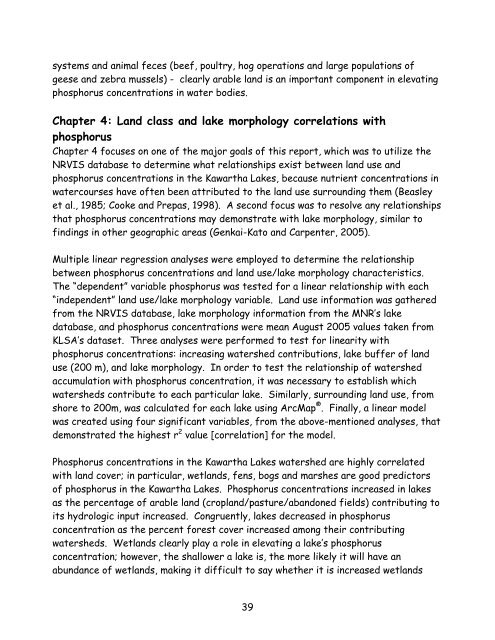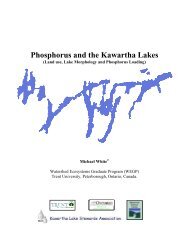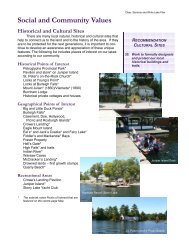Lake Water Quality 2006 Report - Lakefield Herald
Lake Water Quality 2006 Report - Lakefield Herald
Lake Water Quality 2006 Report - Lakefield Herald
You also want an ePaper? Increase the reach of your titles
YUMPU automatically turns print PDFs into web optimized ePapers that Google loves.
systems and animal feces (beef, poultry, hog operations and large populations ofgeese and zebra mussels) - clearly arable land is an important component in elevatingphosphorus concentrations in water bodies.Chapter 4: Land class and lake morphology correlations withphosphorusChapter 4 focuses on one of the major goals of this report, which was to utilize theNRVIS database to determine what relationships exist between land use andphosphorus concentrations in the Kawartha <strong>Lake</strong>s, because nutrient concentrations inwatercourses have often been attributed to the land use surrounding them (Beasleyet al., 1985; Cooke and Prepas, 1998). A second focus was to resolve any relationshipsthat phosphorus concentrations may demonstrate with lake morphology, similar tofindings in other geographic areas (Genkai-Kato and Carpenter, 2005).Multiple linear regression analyses were employed to determine the relationshipbetween phosphorus concentrations and land use/lake morphology characteristics.The “dependent” variable phosphorus was tested for a linear relationship with each“independent” land use/lake morphology variable. Land use information was gatheredfrom the NRVIS database, lake morphology information from the MNR’s lakedatabase, and phosphorus concentrations were mean August 2005 values taken fromKLSA’s dataset. Three analyses were performed to test for linearity withphosphorus concentrations: increasing watershed contributions, lake buffer of landuse (200 m), and lake morphology. In order to test the relationship of watershedaccumulation with phosphorus concentration, it was necessary to establish whichwatersheds contribute to each particular lake. Similarly, surrounding land use, fromshore to 200m, was calculated for each lake using ArcMap ® . Finally, a linear modelwas created using four significant variables, from the above-mentioned analyses, thatdemonstrated the highest r 2 value [correlation] for the model.Phosphorus concentrations in the Kawartha <strong>Lake</strong>s watershed are highly correlatedwith land cover; in particular, wetlands, fens, bogs and marshes are good predictorsof phosphorus in the Kawartha <strong>Lake</strong>s. Phosphorus concentrations increased in lakesas the percentage of arable land (cropland/pasture/abandoned fields) contributing toits hydrologic input increased. Congruently, lakes decreased in phosphorusconcentration as the percent forest cover increased among their contributingwatersheds. Wetlands clearly play a role in elevating a lake’s phosphorusconcentration; however, the shallower a lake is, the more likely it will have anabundance of wetlands, making it difficult to say whether it is increased wetlands39





